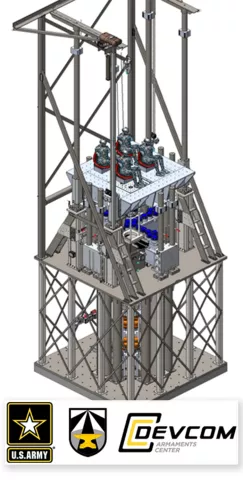GVSC partnered with Lansmont, to build the largest shock test system we have ever designed - the Crew Compartment Underbody Blast Simulator (CCUBS).
The United States Army Combat Capabilities Development Command (DEVCOM) Ground Vehicle Systems Center (GVSC) operates what’s called the Occupant Protection Laboratory at the Selfridge Air National Guard Base, located in Southeastern Michigan. The Laboratory focuses on ground vehicle survivability and protection, and mitigation technologies.
The CCUBS is used to evaluate system and sub-system items such as energy absorbing (EA) seats, bench seats, restraints, EA floors, floor mats, cargo retention devices, and any item that requires dynamic impact testing. ATDs are used in the loop with seating systems and floor mats to record injury data. The results of this testing help validate the performance of seating and restraint systems, to minimize potential injury to the soldiers, while simultaneously maximizing their survivability.
The size and scale of the test system is impressive. GVSC initially dug a 34 ft. pit for the machine, then poured massive concrete reaction mass to help isolate the 70-ton test system inputs from affecting the surrounding facility structure. The CCUBS is mounted to the base of what is now a 24 ft. deep pit, and from the pit floor to the top of the machine is roughly 45 ft. Test payloads of approximately 2,200 lbs. can be subjected to 350g’s, with nearly 11-12 m/sec of velocity.
The machine operation is unique in that the primary energy input occurs by launching a 12,000 lbs. “bullet mass” upwards at user-defined high velocities into the base of the 96 in. x 96 in. test platform. Elastomers mounted to the top of the bullet generate the primary, programmed shock impulse, which can then be followed by a secondary impulse (called slam-down), as the test platform drops back down onto different, comparably softer elastomers. A simple animation of the test system operation is shown below.
ATDs can be used to test and evaluate system and sub-system items such as energy absorbing (EA) seats, bench seats, restraints, EA floors, floor mats, cargo retention devices, and any item that requires dynamic impact testing. The results of this testing help validate the performance of seating and restraint systems, to minimize potential injury to the soldiers, while simultaneously maximizing their survivability.
Time-Lapse video of the CCUBS installation at Selfridge Air National Guard Base:
